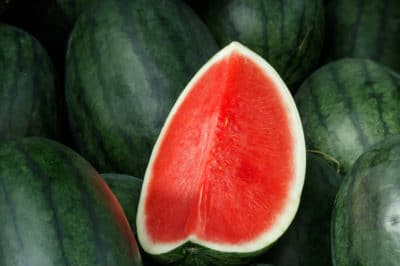Is there a difference between seeded and seedless watermelons when it comes to growing?
Although the end result of both seedless and seeded watermelons is delicious, mouth-watering fruit, if seedless melons don’t receive proper pollination you won’t get any melons no matter how healthy the plants look and how well they are growing.
To sum up their differences:
- Seeded watermelon varieties produce both male and female flowers, so pollination takes place on the same plant.
- Seedless watermelon plants only produce female flowers, so they require pollination from a male. This is possible by planting a seeded variety along with a seedless type, so the male flowers can pollinate the seedless females.
Can I plant any type of seeded watermelon to pollinate my seedless plants?
Any type of seeded watermelon works as long as they have approximately the same days to harvest so the flowers on both plants bloom at the same time.
What’s the preferred climate for growing seedless watermelons?
All types of watermelons, which are warm-season annuals are very sensitive to frost and too cold conditions. Therefore, it’s important for proper seed germination and growth to plant when there’s no longer a threat of frost in spring and temperatures warm.
The best temperatures for the germination of seeds planted directly in the garden are between 70°F to 95°F (21.1°C to 35°C). Germination occurs in several days, when seeds are planted in 95°F (35°C) and can take a week, when planted in 70°F (21.1°C).
Can I get an early start planting my seeds?
To get a jump on the growing season you can plant your seedless and seeded watermelon seeds in peat pots several weeks before your warm weather arrives in spring. Plant the seeds 1/2 inch deep in the soil, place the pots in a sunny and warm location indoors and plant the transplants, entire peat pot, in the garden once temperatures warm.
Expert Tip: Watermelon root systems are very sensitive to disturbance, that’s why peat pots are the best selection when transferring the seedlings into the garden, as you never disturb the roots.
What type of site do the seedless watermelons grow best?
When it comes to watermelon plants putting on their best growth and performance, it’s best to grow them in a preferred site.
- Grow the plants in a site that receives full sun for the majority of the day that is free of weeds and unwanted growth.
- Watermelon plants perform best in fertile soils that drain very well.
What are the spacing requirements to assure pollination?
The spacing requirements are the same for both seedless and seeded varieties. Since you need the seeded type planted close to the seedless plant, so the flowers receive pollination, space multiple hills about 3 feet apart and multiple rows about 8 feet apart. Plant the seeded variety in a row or hill next to the seedless plant.
When do watermelon plants bloom?
Most watermelon plants start blooming about 30 days after germination, with the male flowers appearing first followed by the females soon after. The blooms only stay open for one day so pollination must occur during this time.
How do I water seedless watermelon plants?
Since the majority of a watermelon is made up with water, it goes without saying that proper watering is essential. Water the plants regularly to keep the soil moist but not soggy until the fruits start developing and then cut back watering to half. Too much water during the later stage of fruit development negatively affects the watermelon’s sweetness.
Do I thin any melons from the plant?
If you are growing large, seedless melons, thin to the best two. In addition, if you are growing smaller varieties, you can thin to the best four to six. Remove any of the watermelons that are misshapen.
What are some seedless types of watermelons?
As you will probably notice when searching any online plant catalogue for seedless watermelon seeds, the choices are almost endless. Seedless watermelons come in a host of sizes, colors and days to harvest, so you’re bound to find something you want to grow.
A few of the more common seedless watermelons are:
- ‘Big Tasty Hybrid’: Produces 6- to 8-pound fruits with a greenish-gray outer skin and deep red flesh. Matures in around 85 days.
- ‘Red Ruby Hybrid’: Produces 6- to 8-pounds fruits with green striped outer skin and bright red flesh. Matures in around 85 days.
- ‘Orange Crisp Hybrid’: Produces 19-pound fruits with greenish striped outer skin and bright yellow flesh. Matures in around 90 days.
- ‘Mini Piccolo Hybrid’: Produces 4-pound fruits with green striped outer skin and reddish-pink flesh. Matures in around 80 days.
How to know when my seedless watermelon is ready for harvesting?
The “days to harvest” listed on the seed packet gives you a good idea of how long your seedless watermelons need to grow before they are ripe and ready for picking. Signs of the watermelon’s ripeness include, the tendril attached to the melon dries and turns brown and the melon develops a yellow spot on its belly where it’s laying on the ground.
